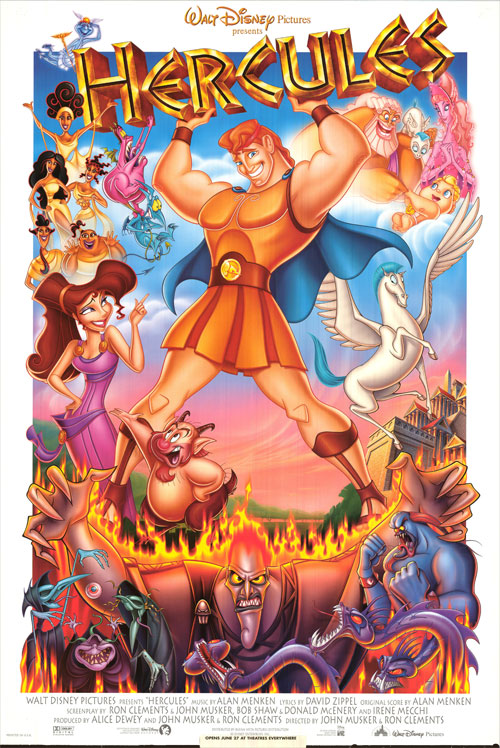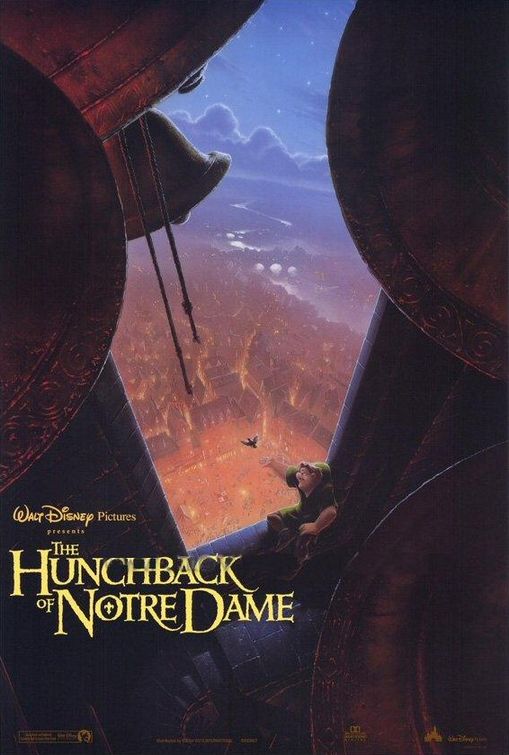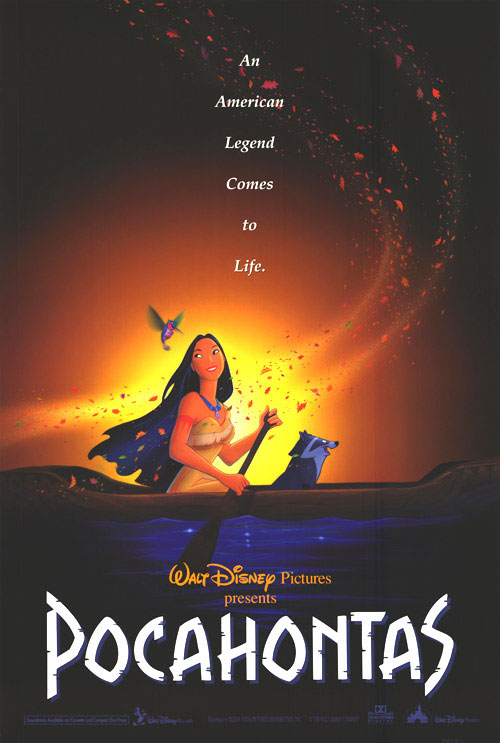
Disney. No one name holds as much power over business and the world of Animation as much as Walter Elias Disney. Whether it was making the first animated motion picture in the English world, further revolutionizing the field of animation, or making one of the most powerful media companies in the world, Disney managed to become a titan of industry and media. Nowadays, we joke about the House of Mouse and its’ lasting impact in today’s world…but without Disney, much of the animated world today…well…wouldn’t be.
Hercules: G-rated classical mythology

Good lord…where do we even begin with this one? Well…after wowing audiences with three epics (maybe…semi-wowing with the second one), Disney decided they needed something…maybe a bit more on the funny side instead of the dramatic side. For some reason, they decided the best way to go was with Classical Greek mythology…riiiiiiight. After many different script changes, getting the artist from Pink Floyd’s “The Wall” movie adaptation, and refining the villain to a fan favorite (you all know the one), Disney decided it was good to go.
The Plot: Long ago in Ancient Greece, the titans ruled over the world and spectacularly mismanaged things. Along came Zeus, who soundly defeated them, trapped them in a vault, and became king of the gods. Zeus and his sister/wife (it’s complicated), Hera, are throwing a party in honor of their new son, who they have named Hercules. All the Gods attend the ceremony…including the God of the Dead, Hades (voiced spectacularly by James Woods). He took a few minutes out of the schedule to meet his new nephew before returning to the Underworld…to plot to rule the world. He’d actually made some pretty intricate plans on how to kick his little brother out of Olympus with a hostile takeover…Hercules was a new variable, though…so he consulted the fates. They predicted that Hades could get the job done if he freed the titans in 18 years when the planets aligned…so long as Hercules didn’t fight back against him.
Deciding that this plan was the one he needed, he had his two minions, Pain and Panic, kidnap Hercules and make him a mortal with a special kind of poison. They nearly succeeded…if not for two mortals almost finding them. As a result, Hercules was almost a mortal. He still had his immense strength…which they found out the hard way when Baby Herc throttled the pair as snakes. Embarrassed and scared of what just happened…they decided not to tell Hades he was still alive. After all…he was still technically mortal…right?
Hera and Zeus found out their son was mortal, and could do little about it but watch him grow up as a mortal who did not fit in because of his strength causing more problems than it did help. As a result of one bad day, Herc was told that he was adopted and his adopted parents showed him the medal he was found with. Resolving to find answers, Hercules journeyed to the Temple of Zeus…where he found the shocking truth that Zeus was actually his father. Zeus, overjoyed to find him alright decided to make him a deal. If he could become a true hero on Earth, Zeus would restore his godhood. Luckily, Zeus knew who to send him to…and how to send him there.
Pegasus was called to send him to an island where Philoctetes, the trainer of heroes (Voiced by Danny DeVito) refused to train him. Phil had seen enough of heroes being trained, it getting to their heads, and then them getting their just desserts (and was particularly upset about Achilles). Zeus convinced him to train him anyway. With the easy part out of the way, Hercules now had the hard part in front of him: Doing heroism. First step was saving a woman named Megaera from a centaur named Nessus…and Hades finding out Hercules was still alive.
Hades, despite being very upset about being lied to…took it fairly well. His first plan was to pit Hercules against a very CGI (pretty good for it’s time) Hydra…which Herc managed to defeat. Hades kept sending everything he had at Hercules (Medusa, the Nemean Lion…who looks a little familiar, the Erumanthian Boar, the Stymphian birds, Cetus) and he kept defeating them…and becoming more and more famous. This…was getting to be a problem.
Hades decided a new tactic was needed. He decided to send Meg to find his weaknesses. Meg had sold her soul to him to save her boyfriend’s life (word of god being that her original boyfriend was Adonis)…and right after she did that, her boyfriend dumped her for someone else. In exchange for finding Herc’s weaknesses…Hades would wipe her debt to him.
Meanwhile, as did happen to most heroes…the fame was getting to Hercules. After most of his childhood being quite miserable, he was enjoying being respected as he was…except that he wasn’t a true hero yet, and he didn’t know how to make good on the “true” part of being a hero. Meg decided to step in and gave Herc a break from hero work…and found herself falling for him…despite her past with men. Hades could see it too…and found a better way to get Herc out of the way…that Phil overheard.
Phil tried to warn him…but Hercules could not fathom Meg betraying him…and promptly sent him away. Following that…Phil was proven right when Hades decided to use meg as a hostage and swap his strength with her freedom. Hercules agreed…finding out the truth just as Hades freed the Titans and sent the Cyclops after Hercules.
The Titans soundly defeated the Gods, and the Cyclops was in the middle of soundly defeating Hercules when Phil returned after being told Hercules life was in danger. The cyclops was defeated…at the cost of Meg’s life and Herc got his strength back to defeat the titans. With that, Hercules burst through the underworld to take Meg’s soul back at the exchange of his own…and it was this act that earned him back his divinity. With that said and Hades punched into the River Styx, Hercules decided he wanted to spend the rest of his life on Earth with Meg…a decision that Zeus and Hera decided was fair before putting Hercules across the sky as a Constellation.
…I cannot even begin to describe just how many liberties they took with this story. As you might imagine…Everyone from Greece hated the many liberties they took with their mythology. It’s true, there are many figures in the myths that made it into the movie…but the way it was handled was sanitized because Greek mythology has many, maaaaaany stories that are most definitely not kid appropriate. To set the record straight, I will be showing what really happened in the myth as someone who deeply enjoys mythology. Buckle your seatbelts…this is gonna be a heck of a ride.
The Real Myth:
We can’t really begin the myth of Hercules without getting to how Zeus became king of the Gods. True, the Titans ruled things before the Gods…and yes, they did mismanage things heavily. Cronus, the king of the Titans, received a prophecy that his rule would be cut short by his own son. As a result, he grew paranoid enough that he devoured his children after they were born (you read that right). His wife, Rhea, was horrified, and saved Zeus by swapping him out with a rock. Upon growing of age, Zeus made Cronus throw up his siblings…who somehow had lived in Cronus’ stomach, and he declared war on the Titans. The Titans lost after a long fight, and the three leaders (Zeus, Poseidon, and Hades) drew straws to determine who got what in the world. Hades drew the short straw and got the Underworld, Poseidon got the Seas, and Zeus got the heavens…and let it go to his head.
Because Zeus was also the youngest…he was a phenomenally immature ruler who let his pants do most of the thinking for him…and his wife/sister, Hera hated him for it. She was goddess of marriage, and she was wed to the most unfaithful of them all. Heracles was born from one of these unions, and Zeus even had the gall to name him after her (Herakles literally means “Hera’s glory”). As a result, Hera decided she would make Heracles’ life as miserable as she possibly could. When he was an adult, he married a woman named Megara (well…they kinda got that right), and they had some kids…until Hera drove Heracles mad enough that he murdered all of them.
Consumed by grief, he was purified by King Thespius and decided to go to the Oracle for any idea he could repent for killing his family. The Oracle directed him to go work for his cousin Eurystheus for ten years to get immortality. Heracles balked at serving a man inferior to him…but relented because he had to follow Zeus’s rules (he was his dad, after all). Eurystheus sent him to complete 10 impossible tasks (eventually 12 because someone helped him on one, and he got payment for another.)
They are as follows:
- Slay the Nemean Lion. Herc had to fight a lion with an impenetrable hide. He got around it by strangling him.
- Slay the nine-headed Lernean Hydra. Hera raised this one to specifically kill Heracles. Much like the movie, destroying one head caused two more to appear…so he had to burn the stumps and bury the last immortal head under a rock to kill it. This was considered null because he had help finding out how to kill it.
- Capture the Ceryneian Hind. This was a humiliating one. If he killed the Hind, he would outrage Artemis, the Goddess of the Hunt, so he asked her to borrow it and she let him…under the condition that he didn’t hurt it. He obliged and humiliated Eurystheus instead.
- Capture the Erymanthian Boar. After getting into a misunderstanding with some Centaurs, Heracles asked for some advice on defeating this one. He heeded Chiron (teacher of many heroes) advice…and drove it into some thick snow).
- Clean the Augean stables in a single day. The stables had not been washed in thirty years…and Herc had to do it in a day. Instead of getting his hands dirty…he redirected a river through the stables. Beforehand, he asked for one tenth of the cattle as payment…which the king agreed to before denying after it was done. Herc killed him, and his son honored the agreement. Eurystheus considered this nullifying the task, and thus added another one.
- Slay the Stymphalian birds. Man eating birds with bronze beaks, metal feathers and poisonous poop. They were also sacred to Ares…and Herc had to drive them away. Athena found this out and gave him a rattle to drive them off where someone else could deal with them (that someone else being the Argonauts.)
- Capture the Cretan Bull. Heracles throttled this one and brought it back. No muss, no fuss. Eurystheus wanted to sacrifice it to Hera…who refused because it would make Heracles look better.
- Steal the Mares of Diomedes. Man eating, fire breathing horses. Herc had to steal them. There are a few ways this one is told, and each one is incredibly messy with Diomedes getting killed (usually fed to his own horses).
- Obtain the girdle of Hippolyta, queen of the Amazons. Hercules actually got along fairly well with the Amazons and would have gotten this one with no fuss…Had Hera not interfered and sowed chaos. As a result, they attacked him, and Herc had to kill a bunch of them…reluctantly.
- Obtain the cattle of the three-bodied giant Geryon. Heracles overcame the two headed dog Orthrus before poisoning Geryon to steal his cattle.
- Steal three of the golden apples of the Hesperides. Depending on the version, Herc enlisted the help of Atlas, or defeated Ladon to get these.
- Capture and bring back Cerberus. The only one where Herc met Hades. Herc busted through the underworld, freeing Prometheus (being punished for giving mankind fire), and Theseus (for reluctantly trying to steal Persephone) to get an audience with Hades. Upon hearing Heracles plight, he allowed Hades to take Cerberus on the condition that he didn’t hurt him (Hades was really fond of his giant, 3 headed dog).
After all this, Heracles was allowed to be immortal, and lived the rest of his life. He sailed with the Argonauts for a bit before settling down again…this time with someone else and doing battle with a centaur named Nessus. Herc defeated him after he tried to steal his wife…so Nessus was fairly upset, and Herc had been away from his wife a while. Nessus laced a tunic with centaur blood and told her to give it to him if she thought he was being unfaithful. She did…turns out centaur blood is incredibly poisonous to immortals. Herc uprooted several trees to make his pyre and jumped on it while Philoctetes lit it…and received Heracles’ bow. Herc then ascended to Olympus.
…How’s THAT for a myth?
James Woods, the voice of Hades, absolutely loves voicing him and whenever anyone asks him to, he will be more than happy to. Hades was actually designed off of Jeffrey Katzenberg, as most villains are designed after former bosses or other people that are disliked by animators (just look at Friz Freling…he got turned to Yosemite Sam). The only problem is…Hades is one of the most fan loved villains out there.
Hercules’ singing voice was, believe it or not, Ricky Martin, going through his big break of being famous.
As mentioned, there were many script changes for Hercules, with Hera originally going to be the villain, the Titans the betrayers, and Hades an ally…and most of this happened in another film…Hercules and Xena (not Disney, but far more accurate, mythologically).



